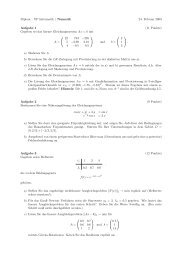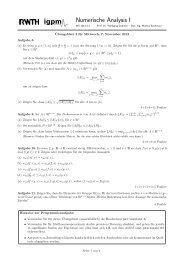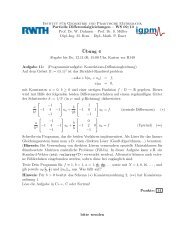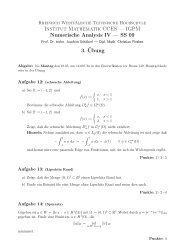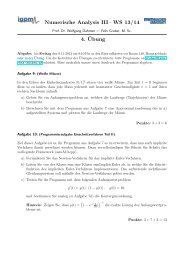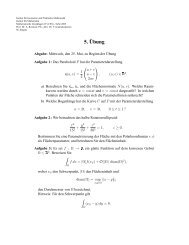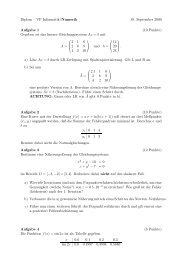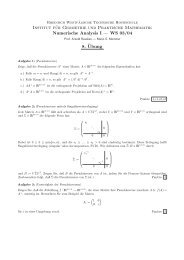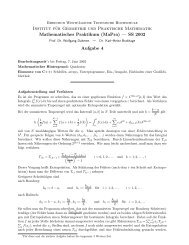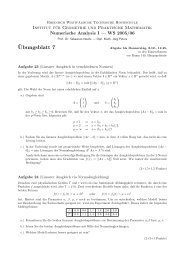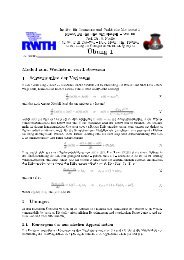preconditioners for linearized discrete compressible euler equations
preconditioners for linearized discrete compressible euler equations
preconditioners for linearized discrete compressible euler equations
Create successful ePaper yourself
Turn your PDF publications into a flip-book with our unique Google optimized e-Paper software.
Bernhard Pollul<br />
bering, the PBGS-preconditioned BiCGSTAB method does not converge in most cases.<br />
With WRG numbering, though, even with large CFL-numbers (e.g. 1000, 5000) the linear<br />
solver converges in most cases if we use PBGS. The WRG algorithm is black-box<br />
and significantly improves the robustness and efficiency of the point-block Gauss-Seidel<br />
preconditioner. For further explanation and properties of this and other renumbering<br />
algorithms we refer to [33].<br />
5 CONCLUSIONS<br />
We summarize the main conclusions. Already <strong>for</strong> our relatively simple model problems<br />
the PBSPAI(0) method turns out to be a poor preconditioner. This method should not<br />
be used in a Newton-Krylov method <strong>for</strong> solving <strong>compressible</strong> Euler <strong>equations</strong>. Both <strong>for</strong><br />
model problems and a realistic application (QUADFLOW solver <strong>for</strong> NACA0012 airfoil)<br />
the efficiencies of the PBGS preconditioner and the PBILU(0) method are comparable.<br />
For our applications the PBILU(1) and PBILU(2) <strong>preconditioners</strong> are less efficient than<br />
the PBILU(0) preconditioner. To achieve a robust preconditioner PBILU(0) and PBGS<br />
can be coupled with a suitable ordering algorithm.<br />
Acknowledgement<br />
The experiments in section 4.3 are carried ot using the QUADFLOW solver developed<br />
in the Collaborative Research Center SFB 401 [37]. The authors acknowledge the fruitful<br />
collaboration with several members of the QUADFLOW research group.<br />
REFERENCES<br />
[1] K. Ajmani, W.-F. Ng and M. Liou, Preconditioned Conjugate Gradient Methods <strong>for</strong><br />
the Navier-Stokes Equations, J. Comp. Phys. 110 68–81 (1994).<br />
[2] E. F. D’Azevedo, P.A. Forsyth and W.-P. Tang, Ordering Methods <strong>for</strong> Preconditioned<br />
Conjugate Gradient Methods Applied to Unstructured Grid Problems, SIAM<br />
J. Matrix Anal. Appl. 13(3) 944–961 (1992)<br />
[3] S. Balay, K. Buschelman, W. D. Gropp, D. Kaushik, M. Knepley, L. C. McInnes. B.<br />
F. Smith and H. Zhang, PETSc, http://www-fp.mcs.anl.gov/petsc/ (2001).<br />
[4] J. Ballmann (editor), Flow Modulation and Fluid-Structure-Interaction at Airplane<br />
Wings, Numerical Notes on Fluid Mechanics 84, Springer (2003).<br />
[5] S. T. Barnard and M. J. Grote, A Block Version of the SPAI Preconditioner, in Proc.<br />
9th SIAM Conf. On Parallel Process. <strong>for</strong> Sci. Comp. (1999).<br />
[6] P. Batten, M. A. Leschziner and U.C. Goldberg, Average-State Jacobians and Implicit<br />
Methods <strong>for</strong> Compressible Viscours and Turbulent Flows, J. Comp. Phys. 137,<br />
38–78 (1997).<br />
16



